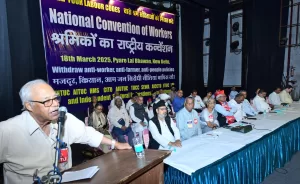❈ ❈ ❈
Les Miserables, Living and Dying on American Streets
Eve Ottenberg
Statistics lie. Some lie more than others. The ones regarding unemployment lie brazenly and have done so for years, erasing the very existence of the long-term unemployed by simply deleting them from the regular tally. Statistics about homelessness lie. But they have an excuse: the homeless are hard to keep track of. So we’re told that roughly half a million Americans have no home. But that statistic is belied by one from the National Center on Family Homelessness, which says 2.5 million children are now homeless each year in America. Add those two numbers together and you get three million homeless Americans. But even that statistic probably undercounts the number of people sleeping in tents, cars, subways, cheap hotels, on friends’ couches or just out on concrete under the stars. So estimate, conservatively, that one percent of Americans are homeless. That percentage only moves in one direction: up.
As the average American single-family dwelling price stays stratospheric despite the cratering real estate market (one of the miracles of modern finance) and rents skyrocket, millions of people stare into the abyss of homelessness. “The cost of living is going up so quickly,” Johns Hopkins University professor Meredith Greif told the Washington Post July 3, “—through the price of gas and food and rent – that more people can’t afford a place to live anymore. Everywhere you turn, prices are rising, but wages aren’t keeping up.” If you think this is some fluke, some mistake, you need seriously to reconsider your take on our economy. The game is rigged, and it’s been rigged like this longer than you’ve been alive.
In 2019, before the covid cash stimulus briefly and refreshingly altered the picture, 40 percent of Americans were unable to cough up $400 in an emergency. So for them, eviction often means sleeping in a car, tent or on the sidewalk. These people are modern-day landless serfs. And what’s happening to the rental market they depend on resembles enclosure: just as, centuries ago, English peasants were barred from farming what previously had been common land, nowadays many tenants are no longer allowed to sleep under a roof, because more and more of those single-family roofs are owned by big private companies who charge exorbitant rents, while apartments are reserved for those able to shell out thousands of dollars a month, a challenge even if you earn the supposedly princely sum of $15 per hour. The main difference between the English peasants and twenty-first century American tenants is that enclosure stole what had been a commons in England, while modern evictees had previously paid most of their meager earnings for a roof and a bed.
“Shelter officials in 15 states all reported a dramatic increase in the number of people, particularly single mothers, seeking services this year,” the Post reported. “In some cases, waitlists have doubled or tripled in a matter of months.” The New York Times tells us on July 15 that the problem is not enough affordable housing. Well, yes. But that’s the real estate development racket – it abhors affordable housing, because it is, well, affordable.
Invisible People, the group that publicizes the dreadful reality of homelessness, puts it starkly: “Spangled flags wave from the tents of homeless veterans. Vegas residents are relegated to sewers like rodents. New York City’s shelters fill with families torn, not by faults but by circumstances. Children’s last belongings are tossed callously into garbage receptacles [by] police…Millennials fearing poverty never leave home.” According to this organization, gentrification and vacation rental companies fuel homelessness. No surprise there. Those two markets cater to the rich, and as far as they are concerned, housing is a privilege, not a right, reserved for the wealthy.
“Inside the lawless tunnel network below the Las Vegas strip, where thousands of homeless people live in fear of being washed away,” headlined an Insider summary back on September 11, 2019. The story sensationalized the crime and drug abuse of those living in “a network of sewage tunnels.” Youtube’s “Wonders of the World” even featured a clip on the “civilization of the homeless in the tunnels under Las Vegas.” They may indeed have a civilization, as perhaps do those who have inhabited New York City’s subway tunnels for decades, but one word describes a society that drives people to such desperation: barbaric.
It’s been that way a long time. Years ago, as the lone housing reporter in Manhattan for the Village Voice, my first column described a Greek immigrant, whose corpse had been found, his face eaten by rats, in a dilapidated Hell’s Kitchen tenement unheated in winter and in every way sedulously neglected by its landlord. At least that owner did not evict his low-income and elderly tenants at gunpoint, as did some landlords, salivating at the prospect of cashing in on the real estate boom. Their crimes, viewed up close, provided quite an education on the class war, indeed gave new meaning to the term.
So it’s no surprise the destitute take to the sewers. On the street, police roust and pummel them. Their presence in public is criminalized, with laws against sleeping on benches, loitering or eating food handed out by the kind-hearted. City police routinely destroy their encampments and trash their meager possessions. Why? Because their existence offends the affluent, who find their misery unsightly, who believe they should not be reminded that in order for the extreme capitalism that serves them so well to function, millions nationally, billions globally, have been dispossessed. In this business of stealing homeless peoples’ tents, clothes, medicines and other few possessions, the Los Angeles police have been absolutely and resoundingly trend-setting.
“As politicians look to build public support for homeless encampment sweeps,” reported Jonny Coleman for The Appeal on May 26, “they’re using tactics popularized in L.A. – the site of one of the nation’s most intense battles over the unhoused.” According to Coleman, “in March 2021, more than 400 militarized LAPD officers descended on Echo Park Lake to destroy a large encampment.” Police arrested or detained over 180 people, Coleman wrote, “and brutalized many more, including members of the media and random bystanders.” The city displaced over 183 people at a policing cost of over $2 million.
Coleman cited three tactics in these displacements: 1) Misleading rhetoric to portray raids as good for the homeless; 2) Fearmongering by conflating homelessness with substance abuse and mental illness; 3) Solutions directed to nonprofits that perpetuate the status quo. Who uses these tactics? Everybody. The NYPD swept away a homeless encampment near Tompkins Square Park in April, arresting eight. “Late last year in San Francisco,” the mayor ignited “a series of encampment sweeps” in the Tenderloin district, while “in Chicago, Fireman’s Park has become a frequent target for homeless removal.”
This is not primarily a mental health problem or a drug abuse problem. It is an economic problem, created by a monstrous economic system that renders millions of people redundant, disposable, deprives them of shelter, then of a living and then unleashes its militarized police, or, if you will, its Gestapo, on them. That chaotic, decaying and lethal system, late capitalism, devoted to one thing and one thing only, namely serving and enriching a billionaire oligarchy, is the same one destroying the biosphere, for those same financial titans. Whatever it touches, it ruins. It is a death cult. Whether it’s the environment or ordinary people or dying species, this economic arrangement withers everything that lives. In this, if nothing else, it is hideously consistent. The wretched of the earth, les miserables, live desperately and often die on our city and suburban streets. This has been the case for decades, but there are many more of them now, as monopolies jack up prices and average people go broke.
To repeat: there’s only one way these numbers move, and that’s up.
(Eve Ottenberg is a novelist and journalist. Her latest book is ‘Hope Deferred’. Courtesy: CounterPunch.)
❈ ❈ ❈
If Poverty Is a Moral Issue, Then the U.S. Is Bankrupt
Sonali Kolhatkar
Newspaper headlines are warning of rising inflation and the possibility that voters will respond to it by punishing Democrats in the midterm elections this fall. But there are few, if any, headlines about the enormous numbers of Americans who are low-income and poor—a travesty in one of the world’s wealthiest nations.
The problem of poverty is marked by several factors, the first of which is a deeply flawed government indicator of who qualifies as poor. Measured by the federal poverty line, about 37 million Americans live below the poverty line—that’s about 11 percent of the population.
But this leaves out many millions more Americans who live one emergency expense away from poverty. The Poor People’s Campaign (PPC): A National Call for Moral Revival relies on economic calculations showing that 140 million Americans—which is more than 40 percent of the population—are poor or low-income.
The second factor is mainstream media coverage that routinely skews in favor of wealthy elites by downplaying the extent of poverty. For example, when President Joe Biden cited the PPC’s estimate in an address in June 2019, the Washington Post engaged in a lengthy fact-checking investigation, interviewing numerous analysts who nitpicked over the difference between “poor” and “low-income” people, saying, “The two terms sound alike, but they describe different economic conditions.”
A third obstacle is corporate greed and how wealthy elites are vacuuming up every dollar they can into their own pockets, taking advantage of an economic system they helped to build in order to benefit themselves. For example, the investment giant Morgan Stanley released a report recently complaining about how rising wages were eating into corporate profits.
But of course, any wage increases are dampened by inflation rates rising much faster. This is a decades-long trend, not a new phenomenon, as any honest economist would explain.
But now that inflation is rising faster than it was before, media pundits and news outlets suggest that the fault lies with Americans earning higher wages and spending too much money.
There is evidence to the contrary—that inflation is rising because of bloated corporate profits, not an increase in wages and consumer spending—a point that the corporate media has failed to elevate or investigate with the same enthusiasm with which it has decided poverty is not a serious national problem.
When Biden was running for president, he addressed the PPC in September 2020, affirming the moral necessity of eradicating poverty and promising to do what he could to end it. The message was consistent with his platform to “Build Back Better,” a slogan that became the name of his ambitious anti-poverty legislation.
In December 2020, after it was clear that Biden had won the election, his transition team reached out to the PPC for a meeting and discussed a list of 14 policies that the organization laid out for his first 100 days in office that included COVID-19 relief for low-income Americans, guaranteed health care for all, a $15 per hour federal minimum wage, and more.
In June 2021, once he was elected, Biden once more reached out to the PPC with a recorded message for the PPC ahead of its annual national gathering affirming his alignment with its goals.
But in spite of Biden’s numerous nods to the PPC and its agenda to eradicate poverty, few, if any, of the organization’s demands have been met. Biden’s Build Back Better bill is languishing, stymied by the stubborn refusal of two corporate Democrats, Joe Manchin (D-WV) and Kyrsten Sinema (D-AZ), to support most of their party’s progressive legislative proposals.
Bishop William Barber II and Rev. Liz Theoharis, the PPC’s co-chairs, recently wrote a letter to Biden requesting another meeting with the White House ahead of their June 18 March on Washington.
In their letter, the two progressive leaders reminded Biden that when he addressed their gathering as a candidate running for office, he “promised that ending poverty would be more than an aspiration.”
According to Barber and Theoharis’ letter, it’s not enough to aspire to enacting anti-poverty measures. They wrote, “We have offered a moral narrative that refuses to accept the lies of scarcity or partisan gridlock as excuses for taking action. We are determined to change the conversation about what is possible, so that we can ensure all of our justice, here and now.”
It’s a call for the president to engage directly with what matters most: not economic phenomena like inflation, not politics and the midterms, but that which impacts more than 40 percent of the nation’s population—poverty and financial precarity.
Rev. Theoharis told me in a recent interview that Biden had made a “commitment to ending poverty, not managing, not ameliorating, to actually looking at the policies that could lift people up.” Still, Theoharis said, “we’ve been pushing and will continue to push Congress because we know that those two Democratic senators [Sinema and Manchin] and 49 Republican senators have stood against living-wage jobs and voting rights.”
Among the anti-poverty measures that the Build Back Better bill would have enacted was the renewal of an expanded child tax credit. During the brief time that an increased child tax credit was in effect, it helped to push millions of American families out of poverty.
Theoharis said that the challenge of making headway on poverty lies in the question of, “how can the president be able to use the microphone that he has to turn it toward poor and low-income people, low-wage workers?” In other words, how can Biden use his bully pulpit to pressure the media and congressional lawmakers into taking seriously the needs of 140 million Americans?
“Any nation that has 43 percent of its population living in poverty or one couple-hundred-dollar emergency away… from absolute economic ruin is an impoverished democracy,” said Theoharis. The PPC has for years been trying to shift the culture and the national conversation away from the pro-business mentality that measures economic health by stock prices and Wall Street’s profits rather than by whether or not most Americans are financially stable.
But Morgan Stanley had it right when it pitted corporate profits against rising wages. There cannot be both rising profits and rising wages. Corporate profits depend on keeping wages low. In order to lift most Americans out of poverty, we need higher wages that will necessarily cut into corporate profits. If Wall Street sees such logic as class warfare, so be it, for Wall Street has been waging just such warfare on the American people for far too long.
“What happens when you actually provide for the people, when you actually ensure that people are making living wages and have housing, is that that actually saves the nation, both spiritually and morally,” said Theoharis, reminding us that what matters much more than the unquenchable thirst of a handful of wealthy elites is the well-being of all Americans.
(Sonali Kolhatkar is the founder, host and executive producer of “Rising Up With Sonali,” a television and radio show that airs on Free Speech TV (Dish Network, DirecTV, Roku) and Pacifica stations KPFK, KPFA, and affiliates. Courtesy: Economy for All, a project of the Independent Media Institute, a nonprofit organization that educates the public through a diverse array of independent media projects and programs.)




